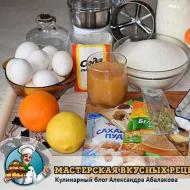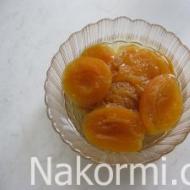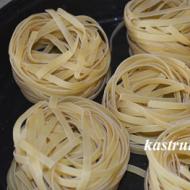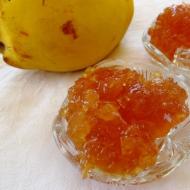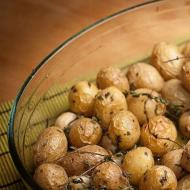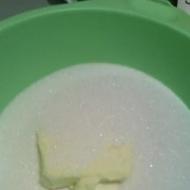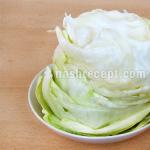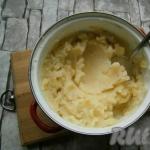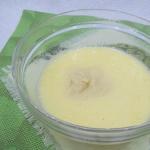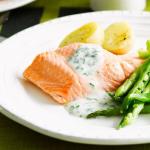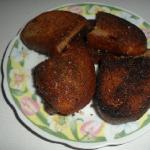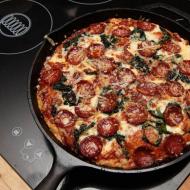
How to make pasta. Pasta machine in home food production
Love pasta and want to know how to make your own pasta at home? Then we will provide you with such an opportunity so that you can please your family with delicious pasta.
Cooking features:
Pasta cooking time: 70 minutes;
Number of servings – 2-4 servings;
The calorie content of pasta is average.
Drink ingredients:
- Salt - a pinch;
- Flour – 300 grams;
- Eggs – 3 pieces.
How to make your own pasta:
- Take the flour and sift it to make the pasta more tasty and tender. In addition, it is necessary to take flour only from durum wheat.
- Pour flour into a bowl in a heap. Make a hole in it, beat in the egg and add salt. Gently knead the dough from the edges to the center, gradually mix the flour into the dough.
- Make sure that the eggs do not spill out of the hole. The dough will contain as much flour as it should. To make it easy to roll out, it should not be too thick.
- Knead the dough until it sticks to your hands. Then we transfer it to a table sprinkled with flour and knead for another 10 minutes. If necessary, add more flour.
- Wrap the finished dough in film and put it in the refrigerator for 30 minutes.
- If you don't have a pasta machine, use a curved or regular kitchen knife for this purpose.
- Divide the dough into 4 parts. Dust the table with flour and roll out each piece thinly. Leave the dough for 30 minutes, and then cut it into thin noodles or wide strips.
- Next, throw the resulting pasta into salted boiling water and boil it for 3 minutes until it floats to the surface.
- Then drain the homemade pasta in a colander, add butter and serve with sauce or just as is.
Now you know, how to make pasta so that they surpass the store-bought equivalent in taste.
Many people know how to cook spaghetti. After all, like any other pasta, you just need to boil it and pour boiling water over it. However, the presented method will only suit you if you plan to serve this side dish with some kind of goulash or sausages with gravy. If you do not plan to prepare such a dish, then spaghetti should be processed slightly differently.
How to cook spaghetti as a regular side dish?
To make this dish as tasty as possible, pasta should be purchased only from durum wheat. Otherwise, during heat treatment, the spaghetti may boil and turn into an unpleasant mushy mass. Moreover, such products contain complex carbohydrates, the processing of which takes a lot of energy, which means that a cooked pasta dish will least contribute to excess weight gain.
So, before cooking spaghetti as a regular side dish, you should purchase:
- spaghetti from durum wheat (as an option, you can use the manufacturer “Makfa”) - 2/3 of a standard pack;
- iodized salt - add to taste (1 dessert spoon);
- drinking water - 2 l;
Cooking process
Delicious spaghetti is great for lunch. Combined with meat goulash and cutlets, this dish will quickly satisfy your whole family.
To boil pasta, take a large saucepan, pour drinking water into it and bring to a boil. Next, you need to put the spaghetti into the seething liquid, having previously broken it, or in its entirety. You also need to add a small amount of salt to the water. To prevent the spaghetti from sticking together, it is recommended to add one large spoon of sunflower oil to it.

Cook the pasta over medium heat for about 8-11 minutes. If the spaghetti was not made from durum wheat, then it is advisable to reduce this time, as otherwise it may become overcooked.
Final stage
The readiness of spaghetti, the photo of which is presented in this article, can be determined as follows: you just need to break the pasta with a spoon, pressing it against the wall of the pan. After the product becomes soft, place it in a colander and rinse thoroughly under cold water. If you plan to serve the side dish immediately, then it is advisable to pour boiling water over the finished products. This way you don't have to heat them in the microwave or in a frying pan.
What is it served with?
Now you know how to cook spaghetti as a regular side dish. You can serve boiled pasta to the table with beef goulash, sausages, salami, sausages, fried vegetables, chicken, cutlets, fish, etc. To give this dish a special taste and aroma, it is recommended to additionally serve it with some sauce, ketchup or homemade marinades. Bon appetit!
Cooking spaghetti in a slow cooker with mushrooms
You can cook spaghetti not only on a regular kitchen stove, but also using a device such as a multicooker. To do this we need a similar set of ingredients:
- durum wheat spaghetti - ½ standard pack;
- iodized salt - add to taste (2/3 dessert spoon);
- drinking water - 1 l;
- odorless sunflower oil - a full large spoon.
Spaghetti can be a side dish for almost any dish. They are prepared in several ways. But many housewives are afraid to use this type of pasta because they do not know the technology for its preparation. Thanks to this article, you will learn not only how to cook spaghetti correctly, but also how to make the most delicious dishes from it.
How to cook spaghetti - cooking secrets
- In appearance, this paste resembles a thin straw. When cooking spaghetti, it is important to remember that pasta will increase in size by 3 times. But it is customary to measure them dry. So for one serving you need 50 g of product.
- Spaghetti is usually boiled. In this case, there is a certain proportion of dry product and water. For every 200 g of paste, use 2 liters of liquid. This abundance of water is not accidental; this way the pasta will be cooked on all sides, and it will not be crowded in the pan.
- There is an opinion that spaghetti is prepared only in special dishes. Experienced housewives claim that the pan can be any kind, but with a thick bottom. The main condition for a tasty dish is to follow the technology of its preparation.
- Fill the pan with purified water and bring it to a boil. To reveal the taste of the pasta, you need to add salt to the water. Use no more than 10 g of salt per 100 g of product.


Advice. It is best to add sea salt when cooking spaghetti, as it has a rich flavor. But at the same time, this salt is saltier, so less of it will be required per 100 g of product.
- There is another important feature of cooking spaghetti - be sure to add a tablespoon of vegetable oil to boiling water. It will prevent the spaghetti from sticking together during cooking and will cover the finished product with a thin film. This way you won't have to use extra oil in your dish.


- The paste is placed only in hot water. If you put spaghetti in cold liquid, it will quickly stick together. You will also not be able to correctly calculate the cooking time.
- Dip one side of spaghetti into boiling water first. Then, as they soften, gently press the paste at the top and gradually lower it into boiling water.


- If this procedure does not work for you, then use a regular frying pan for cooking, but only with high walls.


- Stir the spaghetti frequently during cooking to prevent it from sticking to each other and leaving the bottom of the dish.


- The cooking time for the pasta depends on its type and the dish in which you plan to use the product. So spaghetti made from durum wheat takes longer to cook than regular types of pasta. For a side dish with meat, cook spaghetti for about 8 minutes; for salads, cook pasta for 10 minutes. If you add hot sauce to the dish, then cook the product for no more than 6 minutes.


Important! Each type of spaghetti has a different cooking time. Therefore, carefully study the instructions for each new variety of pasta.
- Drain the boiling water from the finished pasta using a colander. If you plan to use the spaghetti as a side dish, then immediately return it to the empty pan.


- For casseroles and salads, pasta should be rinsed with cold water. This will stop the cooking process.


How to cook spaghetti with bacon and tomato sauce
It is customary to prepare various sauces for pasta, but a particularly tasty dish is obtained with tomato dressing. To prepare 200 g of spaghetti you will need the following products:
- meat broth – 400 ml;
- red wine – 1 tbsp.;
- onions – 1 pc.;
- garlic – 2 teeth;
- cherry tomatoes – 12 pcs.;
- arugula or salad - 1 bunch;
- zucchini – 1 pc.;
- tomato paste – 1 tbsp. l.;
- hard cheese – 100 g;
- salt and spices to taste.


- Step 1. Dilute the water for cooking spaghetti with broth, but use only half of its volume. It will make the dish more satisfying. There is no need to add vegetable oil, since the meat broth is fatty.


- Step 2. When the liquid boils, add salt and add pasta. After a couple of seconds, lower the spaghetti completely into boiling water.


- Step 3. Let the pasta cook for the time indicated on the package. At the same time, do not forget to stir them.


- Step 4. While the spaghetti is cooking, prepare the dressing for the dish. Cut the onion into cubes and sauté in hot oil in a frying pan. Reduce the heat to minimum.


- Step 4. When the onion turns golden, add chopped bacon to it. You can use minced meat instead. Lightly fry the mixture.


- Step 5: Increase the heat to high and add the tomato paste. Mix it well with the onion and bacon.


- Step 6. Cut the cherry tomatoes into slices or in half and add to the pan. Immediately pour in the wine and add the chopped garlic. Simmer the mixture for about 5 minutes so that the alcohol completely evaporates.


- Step 7. Cut the zucchini into cubes and add to the tomato sauce in the pan. At this stage, season the dish with spices and salt. If desired, you can add hot ketchup, but this is not necessary.


- Step 8. Pour the remaining broth into the mixture and simmer the sauce until the liquid in it evaporates. The dressing should be thick.


- Step 9. Meanwhile, your spaghetti should be cooked. Drain the pasta in a colander.


- Step 10. Then grate the cheese on a coarse grater.


- Step 11. Wash the greens, sort them and dry them from excess moisture. Place it evenly on a plate.
Step 1: prepare the flour.
First of all, we place a large wooden board on the countertop and, using a sieve with a fine mesh, sift two types of flour onto it: coarse and premium. This must be done so that these ingredients dry out, become more loose and get rid of any kind of litter, which very often ends up in bags along with wheat ground into dust.Step 2: prepare the dough.

Next, collect the flour in a mound and make a depression in its center.

Put a couple of raw chicken eggs without shells and a pinch of salt there. Then we arm ourselves with a dinner fork and begin to gradually mix these ingredients with whisking movements. We act slowly, taking flour from the edges in small parts.

When this cutlery stops helping, we continue the process with clean hands, using a kitchen spatula to help ourselves remove pieces of stuck dough from the board.

If the semi-finished flour product is not kneaded, add a little purified cold water, but this does not mean that you need to pour out half or a whole glass, 30–40 milliliters will be enough, or maybe less.

As a result, the dough should be very hard, fairly, but not too smooth, this is not scary, since we will roll it out using a special Italian machine, which will give it the desired density and structure.
We send the finished semi-finished flour product into a plastic bag and leave it there for 15–30 minutes, so that he rests, after which it will be easier to work with him.
Step 3: Roll out the dough.

After the required time, plug in the plug of the pasta machine, place the dough on a floured board, knead it slightly and divide it into three equal parts with a knife. We set the kitchen appliance to the highest number, that is, the layers will come out very thick. Then we turn on the start and pass a piece of semi-finished flour product through the metal plates.

Immediately after this, fold it into three layers and repeat this process again 4, 5, 6 times, or until the dough becomes smooth and beautiful. Roll out the remaining parts in the same way.

Then we set the machine to the middle number and pass the layers of semi-finished flour product through it once at a time, this will make them thinner. We crush them with a thin layer of flour, place them on top of each other and divide them with a knife crosswise into 2 equal parts, resulting in 6 rectangular cakes.

Next, we set on the kitchen appliance the thickness that we want to get for the spaghetti. Again we pass 6 pieces of rolled out dough through the machine, but this time each 2 times, and proceed to the next step.
Step 4: form and dry homemade spaghetti.

We install a special attachment on the machine for cutting Tagliolini pasta, as spaghetti is called in Italy, and with its help we cut the first piece of rolled semi-finished flour product. In fact, everything is very fast, in a couple of seconds you will be holding a bunch of long and rather thin pasta in your hands.

Sprinkle the resulting products with flour to prevent them from sticking together, and in the same way grind the remaining layers of dough until they are all gone. We leave the resulting spaghetti on a cutting board so that the long noodles do not come into too much contact with each other, lightly dust with flour, dry and then use for their intended purpose.
Step 5: Serve homemade spaghetti.

After cooking, homemade spaghetti is dried a little and then boiled in plenty of salted water until fully cooked, about five minutes. Then they are thrown into a colander, left in it for a few minutes to drain off excess liquid, and served as a side dish or used to prepare second hot dishes. Such pasta is very different from store-bought ones in that it has a richer taste and a truly homemade aroma. Enjoy delicious food!
Bon appetit!
Ready spaghetti can be completely dried and stored in a plastic or paper bag in a dry place until required;
If you want to make spicy spaghetti, before kneading the dough, add some aromatic dried herbs and spices to the flour, for example, sage, mint, savory, lemon balm, and these are just a few of all the possible options;
If you plan to use spaghetti after cooking to prepare other dishes, then it is better to subject it to primary heat treatment not for 5, but for 2–3 minutes, even if it is a little damp, it will still reach the desired level during baking or stewing;
Any pasta cools down very quickly, so they should be served immediately and preferably on pre-heated plates;
To cook 100 grams of spaghetti, you need at least 1 liter of purified water.
No store-bought pasta can compare with homemade noodles. Flour of the highest quality and careful rolling will allow you to make an indispensable addition to aromatic chicken broth.
Rolling out the dough is somewhat difficult due to its rigidity. Having sprinkled it generously, you can roll it up into several folds and continue working. The procedure is repeated, making folds in different places, until the layer becomes transparent. Before cutting, the workpieces can be slightly dried in the oven.
The finished vermicelli must be dried thoroughly, allowing it to sit for at least half an hour. Long-term storage implies fragility of the product.
Ingredients

- 1 egg
- 100 ml milk
- 2 pinches of salt
- 1-1.5 tbsp. wheat flour
Preparation
 1. In Soviet times, pasta was created only from yolks, salt and flour, but such dough was so difficult to roll out that vermicelli became unfairly forgotten and gave way to quick porridges and vegetable side dishes. In order not to bother ourselves with a long roll out of non-plastic dough, we will simply add milk to it, thereby giving it both plasticity and taste! If you have a bread machine, knead the noodle dough in it, while simultaneously adding all the ingredients to the machine’s bowl.
1. In Soviet times, pasta was created only from yolks, salt and flour, but such dough was so difficult to roll out that vermicelli became unfairly forgotten and gave way to quick porridges and vegetable side dishes. In order not to bother ourselves with a long roll out of non-plastic dough, we will simply add milk to it, thereby giving it both plasticity and taste! If you have a bread machine, knead the noodle dough in it, while simultaneously adding all the ingredients to the machine’s bowl.
 2. If not, then pour wheat flour into a container, making a depression in it, and beat a chicken egg into it, pour in milk and add salt. Knead the dough and let it rest for 15-20 minutes. In a bread machine, this process takes a minimum amount of time.
2. If not, then pour wheat flour into a container, making a depression in it, and beat a chicken egg into it, pour in milk and add salt. Knead the dough and let it rest for 15-20 minutes. In a bread machine, this process takes a minimum amount of time.
 3. The dough turns out kneaded, dense and elastic.
3. The dough turns out kneaded, dense and elastic.
 4. Divide it into two or three parts and roll each of them to the thickness of newspaper into a layer.
4. Divide it into two or three parts and roll each of them to the thickness of newspaper into a layer.
 5. Cut the layer into strips 1.5-2 cm wide - this width will become the height of the vermicelli, remember this when you cut the strips.
5. Cut the layer into strips 1.5-2 cm wide - this width will become the height of the vermicelli, remember this when you cut the strips.
 6. Then place the strips one on top of the other and cut into thin, thin cubes - the homemade noodles are completely ready!
6. Then place the strips one on top of the other and cut into thin, thin cubes - the homemade noodles are completely ready!
 7. Now, in order for the cooked pasta to be stored for a long time, it must be thoroughly dried. To do this, pour the vermicelli onto a wide board and spread it over it. Dry in the sun or at room temperature for at least 24 hours, stirring occasionally. You can dry vermicelli in the oven for 1-1.5 hours at 80-100 degrees.
7. Now, in order for the cooked pasta to be stored for a long time, it must be thoroughly dried. To do this, pour the vermicelli onto a wide board and spread it over it. Dry in the sun or at room temperature for at least 24 hours, stirring occasionally. You can dry vermicelli in the oven for 1-1.5 hours at 80-100 degrees.
 Store the finished semi-finished product in a special container or in a tightly tied bag, using it as needed.
Store the finished semi-finished product in a special container or in a tightly tied bag, using it as needed.
Note to the hostess
1. The key to successful pasta is high-quality flour from a trusted manufacturer. In this case, even from the first grade, you will need only the highest.
2. When you put a tray of noodles in the sun, you definitely need to cover it with something, otherwise dust will inevitably get on the product, insects, and maybe even birds will flock to it. Under the cover of gauze or fine mesh, it will dry perfectly and remain clean, but denser fabric, foil and paper will not provide such conditions, because they will not allow air and sunlight to pass through.
3. Carefully cutting the thinnest dough without deforming the rolled out layer is a difficult task. In such a culinary process, a sharp wheel-shaped knife is indispensable. Its edge can be smooth or jagged. Both options are suitable.
4. To store homemade noodles, it is better to choose a spacious container. The jar should not be filled to the very neck, otherwise its contents in the lower part will crumble under the weight of the top layer. For bulk grocery products, glass containers with screw or ground-in lids are recommended. It is allowed to use food grade plastic, but not metal. It is worth checking periodically to see if moisture has accumulated in the storage.

